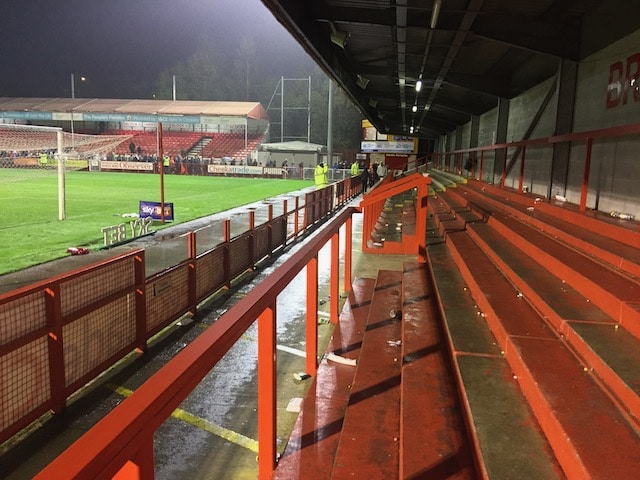The question about safety at English soccer games is one I get a lot. I…
Will There be Safe Standing at Football Games in England?

Is “safe standing” coming to football games in England?
After the Hillsborough Disaster of 1989 and the subsequent Taylor Report, terraces were replaced by seats at all English football stadiums. Now, safe standing is being trialed by several Premier League clubs.
In this post, Groundhopper Soccer Guides summarizes the events that led to the removal of terraces from stadiums, and the changes being made to once again allow fans to stand during games.
The History of Fans Standing at Football Games
In the beginning, most viewers at English football grounds stood rather than sat. According to Wikipedia, this usually consisted of standing areas at each end and, often, in lower stands along the sides. Even in the late 1980s, “the average standing capacity in grounds was roughly twice the number of seats.”
Open standing areas on terraces, simply known as terracing, was a cost-effective way to put as many people as possible into a ground. The basic problem, though, was safety. People could be crushed, terraces were often poorly built and prone to collapse, sanitation was almost non-existent, and when hooliganism arose in the 1970s, the terraces also became effective battlegrounds.
The Heysel and Hillsborough Disasters and the Taylor Report
Twin disasters in a span of only four years led to major changes at football grounds across the UK.
In 1985, prior to the European Cup Final between Juventus and Liverpool at Heysel Stadium in Brussels, Belgium, hooligans from the opposing teams (who were only separated by chain link fencing in one end of the standing terraces) started throwing flares, bottles and stones. In the rush to flee a charge by Liverpool supporters, 39 Juventus fans were killed when part of a perimeter wall collapsed. Another 600 people were injured.
In 1989, prior to an FA Cup semifinal, 97 Liverpool supporters were crushed to death from overcrowding on the Leppings Lane terrace at Hillsborough Stadium. The subsequent inquiry, led by Lord Justice Taylor and known as the Taylor Report, concluded that authorities had failed to establish safe capacities in standing areas, and that there was no effective way to monitor crowd density. Of the 76 recommendations in his report, the major changes that took effect were the banning of alcohol sales and consumption within stadiums, the removal of fencing meant to keep fans off the pitch, and the requirement that stadiums get rid of terraces.
You can read more about both events and the Taylor Report in this post.
Is Standing Allowed in English Football?
In recent years, it’s quite common for entire sections of away fans to stand throughout the game, simply because it’s fairly impossible for stewards to enforce the rule on thousands of fans at once. Also, from the third-tier League One and down in the English football pyramid, open terraces have existed for years. A few clubs, such as Brentford at their old Griffin Park home, or Peterborough United today, have even been allowed to continue with terracing after promotion to the second-tier Championship.
No teams in the Premier League have been allowed to have standing areas or terracing.

Safe standing area fitted with rail seats in the AWD Arena, Hannover, Germany. (Photo by Jon Darch, CC BY-SA 3.0 via Wikimedia Commons)
What is Safe Standing, also known as Rail Seating?
Safe standing terraces feature fold-up seats with built-in safety barriers which allow spectators to either sit or stand. Each seat is incorporated into a strong metal frame with a high back, which forms a sturdy and continuous handrail to facilitate safe standing. The rail also provides a protective barrier which prevents spectators from falling or pushing those in front of them.
In August 2019, the UK government commissioned independent research which concluded that such a setup “almost completely eliminate(s) the possibility of forwards or backwards movement during goal celebrations and the risk of a surge that could cause injury to those in front.”
As a result of the study, the government invited applications for early adopters of licensed standing in seated areas. Grounds selected had to meet certain criteria such as that fans must be able to sit or stand (seats cannot be locked in the up or down position), one seat/space per person, and CCTV must be in place with coverage of the entire standing area.
Which UK Football Clubs have Safe Standing Sections?
Seven Premier League clubs along with the Championship’s Cardiff City FC in Wales have included safe standing sections in their stadiums, with some installing rail seats ahead of the start of last season.
Safe Standing at Chelsea’s Stamford Bridge
On January 2, 2022 fans stood at Stamford Bridge for first time since 1994 when Chelsea hosted Liverpool in a Premier League fixture. More than 12,000 safe standing spaces have been created in the Shed End and the lower tier of the Matthew Harding Stand.
Safe Standing at Manchester City’s Etihad Stadium
Throughout the trial period, Manchester City fans who hold season tickets in the club’s rail seating installation in the South Stand of the Etihad Stadium will have the opportunity to stand for the duration of the match, should they wish to do so. Level 1 (blocks 113 and 114) of the visitors’ section is also included.
Safe Standing at Manchester United’s Old Trafford
The match against Wolverhampton Wanderers on January 3, 2022 was the first game to be played at Old Trafford as part of the trial, with 1,519 barrier seats in use within the North East quadrant section (also known as J Stand), plus 571 in the away section.
Safe Standing at Tottenham Hotspur Stadium
Spurs have safe-standing areas at the front of the stadium’s new 17,500 capacity single-tier South Stand, as well as in the visiting supporters’ section.
Safe Standing at additional Premier League clubs
Liverpool will have over 13,000 safe standing seats when the construction on the Anfield Road Stand is completed. Wolverhampton Wanderers have also introduced safe standing at their home ground Molineux since March 2023. Both Aston Villa and Newcastle also have plans to gradually introduce safe standing during the 2023-24 season. Everton and Luton Town do not plan to put in safe standing areas at their current stadiums, but have pledged to do so in their newly constructed stadiums.
Will There be Safe Standing in the Premier League?
The current trial is part of a process to determine whether safe standing may be introduced, or allowed, in the Premier League starting with the 2022-23 season. Acknowledging many fans’ desire to stand at games, the government official running the pilot said, “Independent research conducted recently has identified the safety risks related to persistent standing in seated areas. It has also evidenced the positive impact engineering solutions, such as seats incorporating barriers or independent barriers, can have.”
So yes, it would appear that safe standing will come to the Premier League, because fans want it, and the government believes it can be done in a safe way.
Safe Standing in Europe and the U.S.
Safe standing areas have been common in Germany for years; almost half of the top-flight Bundesliga clubs convert standing areas to all-seater configuration by using rail seats. Several French clubs have also taken part in a pilot program.
Safe standing is also common in American/Canadian Major League Soccer. San Jose debuted it first in 2015, followed by Orlando City in 2017, Los Angeles FC in 2018, and Minnesota United in 2019. Most other stadiums tolerate a de facto standing section behind a goal, such as the Timbers Army at Providence Park in Portland, where a general-admission section of more than 6,000 seats allows people to stand.










Post Comments